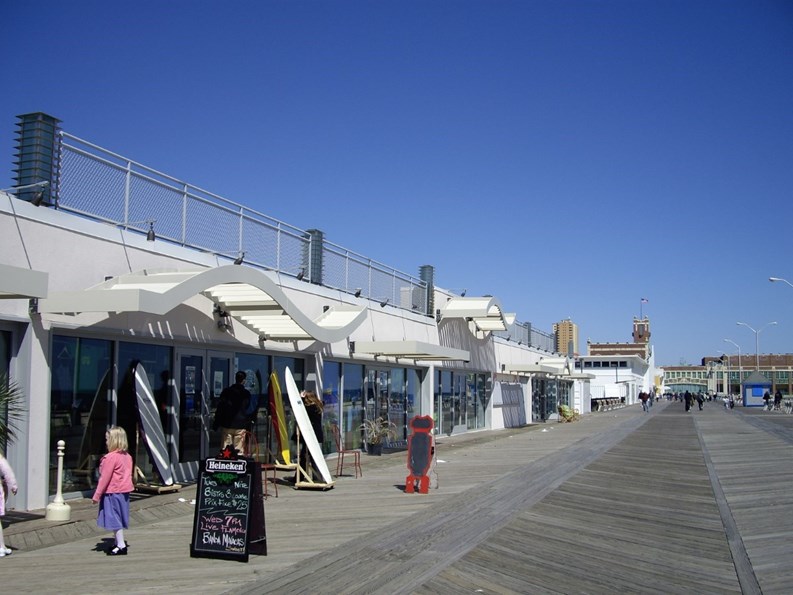Asbury Park, one of the old showplaces of the Jersey Shore and a town that in its heyday rivaled Atlantic City, has seen its fortunes rise and fall (and rise again). Once viewed as a city in decline, Asbury Park benefited greatly from the housing bubble of the early 2000s, and seemed poised for a renaissance of sorts. Today, the future of development and gentrification in Asbury Park is less clear, as the tanked economy has forced many of the residential projects in the pipeline into a kind of limbo, their funding tied up or evaporated and unit sales sluggish at best.
The current doldrums are another rough patch in a city that has seen its share of tough times, but whose storied history and iconic boardwalk have been immortalized on film and in music.
In the Good Old Days
Asbury Park was founded in 1871 by developer James A. Bradley, a devout Methodist who was visiting Ocean Grove, then a Methodist retreat center. Bradley named his new town after Francis Asbury, the founder of Methodism in America, and basically planned it from the ground up, encouraging the development of trolleys, hotels, the waterfront, a sewer system, an amusement park, a fishing pier, a commercial section, and, of course, churches. In the early days, when Bradley still controlled the town, he patrolled the beaches personally, looking for signs of drinking or people wearing “immodest” attire.
In the 1920s, the Casino and Convention Center were built, and Asbury Park became one of brightest lights on the Jersey Shore, rivaling Atlantic City. “It was a jewel,” says Daniel DiBenedetto, head of both the Asbury Park Chamber of Commerce and Planning Board. “People used to come from New York, from Philadelphia. The Waldorf-Astoria built the Berkeley Cateret hotel [which was renovated in 2007] here. Judy Garland and Frank Sinatra played here.”
This reporter spent a summer vacation at Asbury Park as a child in the mid-1960s, and while it may have faded a bit from its glamour days by that point, it was still vibrant and very much alive. The beaches were packed, the hotels and motels were full, the boardwalk and the amusement rides thronged with fun-seekers.
Around the same time, a teenager from Freehold named Bruce Springsteen was jamming with his friends at a club called the Upstage. There were dozens of clubs and bars on or near the boardwalk at the time, and indeed, Springsteen is the image that most of the outside world has of the city, thanks to his 1973 debut album, Greetings from Asbury Park. But even he knew that his scene was on the decline—in his song “Fourth of July, Asbury Park [Sandy]” from his follow-up album The Wild, the Innocent and the E-Street Shuffle he declared, “This boardwalk life for me is through.”
Violence and Greed
So what factors contributed to Asbury Park’s transition from a hub of entertainment and activity into a gritty, economically depressed cautionary tale?
According to DiBenedetto, the opening of the Monmouth Mall in 1960 had a chilling effect on Asbury Park’s economy. “All the suburbanites started shopping there, and not in Downtown Asbury,” he says. “Also, there was an exodus of people into suburbs and McMansions.”
DiBenedetto also blames “a lot of questionable politicians over the years;” and John Loffredo, an Asbury Park city councilman and local realtor, holds “stupidity and greed” responsible for the community’s spiraling fortunes in the Postwar era.
Hand-in-hand with economic woes, tension over racial inequality was a major contributing factor in the de-glamorization of Asbury Park. The city’s beaches had been segregated from start, when Bradley declared that he had “nothing against colored people,” but had to protect his investments. (The town founder also had similarly distasteful remarks to make about the immigrant laborers who helped build his city.) As late as the 1940s, the city’s beaches were still divided, and as more and more residents abandoned Asbury Park for more affluent suburbs, minority residents increasingly felt that they had been left out of the prosperity that others in the city had enjoyed.
In 1970, tensions and resentment boiled over into a full-blown riot that lasted almost a week and destroyed about five blocks of the city’s west side. Nearly 50 people were wounded by state troopers over the course of the disturbance, and a dusk-to-dawn curfew was temporarily imposed. The incident left the community deeply rattled and did little to encourage residents or businesses to invest in Asbury Park.
Fallout from the riots further exacerbated an already bad economic situation. According to the New York Times, there were 10,000 hotel and motel rooms in Asbury Park in 1966. By 1976, there were fewer than 1,500. In the 1980s, the Asbury Park Press, still one of the largest papers in New Jersey, moved its operations out to the suburbs. Another slap in the face came in 2002, when Asbury Park was chosen a stand-in for Long Beach, New York for the gritty crime movie City by the Sea starring Robert DeNiro—because the producers didn’t think Long Beach itself looked seedy enough.
Indeed, when this reporter visited the city six years ago, “gritty” was certainly an apt description of Asbury Park proper. Many buildings downtown—including the famous multi-level Steinbach’s Department Store—were empty, and the area didn’t feel safe. Few people were on the boardwalk, and just about the only place that seemed vibrant and alive was the Stone Pony rock club, which has been there since the early 1970s and helped launch the career of Southside Johnny. The contrast with neighboring Ocean Grove, with its quaint, brightly colored houses, was notable.
New Attempts at Redevelopment
In the late 1970s and ‘80s, Atlantic City experienced a revival due to its legalization of casino gambling, although many observers criticized its renaissance as being limited to the boardwalk and not helping the town’s poorer residents. Where was Asbury Park redevelopment during this time?
Actually, several attempts have been made over the years to remedy what has ailed Asbury Park, with varying levels of success. In the 1980s, the city adopted a $550 million redevelopment plan, which included the Ocean Mile condominium project. Construction on the condos began, but came to a grinding halt when developer Joseph Carabetta declared bankruptcy—in part because of the recession of that era. The hulking skeleton of the unfinished Ocean Mile tower stood for years as a symbol of the redevelopment plan’s failure. It was finally demolished in 2006—and ironically, the location then became the site for the Esperanza, another condo development whose progress has been stalled by this decade’s recession.
“The redevelopment rights were tied up in the bankruptcy courts in Connecticut for years, but around 1999 they were released,” says DiBenedetto. “Around 2000, they were made available again for a new developer to come in.” In 2002, Asbury Partners LLC purchased the redevelopment rights from the bankruptcy court.
Once freed from legal limbo, the huge redevelopment project—called Oceanfront Asbury—began in earnest as a collaboration between the city itself and several developers. Loffredo calls it a genuine public-private partnership: the City Council and the city’s redevelopment agency both approved it.
The project hasn’t gotten carte blanche, despite its overall support. “There is some dissent,” says Loffredo, “some people say we’ve been cutting people out and catering to the rich, but it’s not true.” As proof of this, he cites last year’s Springwood Avenue Redevelopment Plan, proposed to help revitalize the city’s low-income West Side and points out that the Oceanfront Asbury plan also contains a commitment to provide $7 million for affordable housing. Under local laws, says Loffredo, the developers can either build affordable units onsite or give money to the city to build it elsewhere. “Some people would prefer that, because it would give the city more freedom to develop them the way it wants,” he adds.
Described in promotional literature as “a 56-acre waterfront redevelopment plan that includes residential, retail and entertainment components, municipal services and urban empowerment initiatives,” Oceanfront Asbury will take a decade to complete and is projected to produce more than $1.25 million in total economic redevelopment.
Today, the Oceanfront Asbury project is well under way, although much work still remains to be done, and the cast of involved parties has changed several times. For example, Paramount Homes has been developing a three-building complex known as North Beach Asbury Park. The company sold all 48 units in its first building, the Barcelona, in less than a month in 2005, and when another building, the Seville, opened for occupancy in February 2007, prices ranged from $500,000 to more than $1 million.
Condos are a big part of the redevelopment plan. John Clarke, Oceanfront Asbury’s chief planner and urban designer, says that some 3,164 units are either planned or already built. He adds that rental units are also part of the development plan, although their number has not yet been determined.
Other Developments—and Disappointments
Another firm, Philadelphia-based Madison Marquette, signed on in March of 2007 to revitalize the boardwalk. According to spokeswoman Courtney Johnson, the company has thus far renovated and restored the historic Paramount Theatre, Convention Hall, Grand Arcade, and Carousel Buildings to be venues for everything from rock shows to film screenings. In its first foray into residential development, the firm has also taken over the Wesley Grove townhouse development from an earlier developer, Kushner Companies. Wesley Grove will eventually include 750 two- and three-bedroom townhouse condos.
Independently of the waterfront redevelopment plan, other projects are in various stages of development in downtown Asbury Park, most centering around Cookman Avenue. For example, the aforementioned Steinbach’s department store building now contains rental apartments and a restaurant on the ground floor. Some condos have been built in the downtown area, and other condos have been built near the lake separating Asbury Park from Ocean Grove. No matter what is built, says Clarke, it will follow Asbury Park’s historic, unique street pattern, where the streets are narrower inland, but open up and become wider as they approach the boardwalk.
While development in some areas continues, other projects have stalled, fallen prey to the current recession and the evaporation of funds. The aforementioned Esperanza is one casualty of the economic collapse. The building’s marketing website is still up, but the development company stopped construction of the Esperanza and closed its sales offices in late 2007, though Loffredo says the company is revamping its plans. The president of Metro Homes, the development company behind the Esperanza, has cited the impact of the subprime mortgage crisis as a reason for the halt in activity, and been quoted as saying he’s working to get the development “back on track.”
The Esperanza’s travails are just one story among many—other Asbury Park development projects are limping along behind schedule, have been downscaled from their original ambitions, or have stalled out entirely as funding has become frozen. That being said, hope springs eternal in a town that’s survived more than its share of ups and downs over the decades. How well this latest incarnation of Asbury Park weathers the current economic storm might best be summed up by Madison Marquette president Gary Mottola: “While we are confident that Asbury Park’s waterfront revitalization effort can succeed, we believe that success will be dependent on two critical factors. First, an immediate, unified development effort on a major scale; and second, the extensive involvement of the community by private enterprise.”
It’s hard to say when those factors will align for Asbury Park, but when they do, the jewel of the Jersey Shore may once again regain some of its former sparkle.
Raanan Geberer is a freelance writer and editor living in New York City.







Leave a Comment